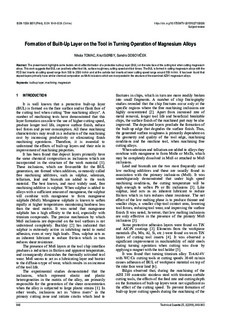| dc.contributor.author | Tomac, Nikola | |
| dc.contributor.author | Sørby, Knut | |
| dc.contributor.author | Doboviček, Sandro | |
| dc.date.accessioned | 2018-07-09T08:21:08Z | |
| dc.date.available | 2018-07-09T08:21:08Z | |
| dc.date.created | 2018-07-03T11:04:18Z | |
| dc.date.issued | 2018 | |
| dc.identifier.citation | Tehnicki Vjesnik. 2018, 25 (3), 940-943. | nb_NO |
| dc.identifier.issn | 1330-3651 | |
| dc.identifier.uri | http://hdl.handle.net/11250/2504750 | |
| dc.description.abstract | The present work highlights some factors which affect formation of a protective built-up layer (BUL) on the rake face of the cutting tool when cutting magnesium alloys. This work suggests that BUL can positively affect tool life, surface roughness, cutting speed and tool forces. The BUL is formed in cutting magnesium alloys with the PCD tool inserts at cutting speed range from 500 to 2500 m/min and at the carbide tool inserts at lower cutting speed range around 550 m/min. It has been found that deposit layers primarily have similar chemical composition as MnAl inclusions which are incorporated in the structure of the examined AZ91 magnesium alloys. | nb_NO |
| dc.language.iso | eng | nb_NO |
| dc.publisher | Faculty of Mechanical Engineering in Slavonski Brod, Faculty of Electrical Engineering in Osijek, Faculty of Civil Engineering in Osijek | nb_NO |
| dc.title | Formation of Built-Up Layer on the Tool in Turning Operation of Magnesium Alloys | nb_NO |
| dc.type | Journal article | nb_NO |
| dc.type | Peer reviewed | nb_NO |
| dc.description.version | publishedVersion | nb_NO |
| dc.source.pagenumber | 940-943 | nb_NO |
| dc.source.volume | 25 | nb_NO |
| dc.source.journal | Tehnicki Vjesnik | nb_NO |
| dc.source.issue | 3 | nb_NO |
| dc.identifier.doi | 10.17559/TV-20151027130036 | |
| dc.identifier.cristin | 1595379 | |
| cristin.unitcode | 194,64,92,0 | |
| cristin.unitname | Institutt for maskinteknikk og produksjon | |
| cristin.ispublished | true | |
| cristin.fulltext | original | |
| cristin.qualitycode | 1 | |
